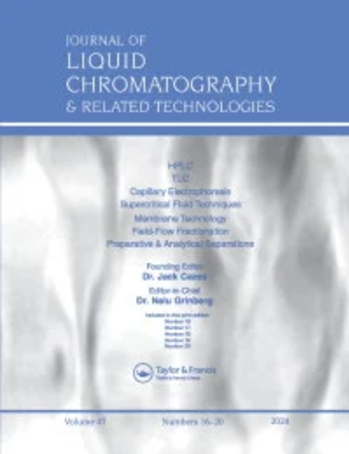Characterization of quality differences of Ophiopogonis Radix from different origins by TLC, HPLC, UHPLC-MS and multivariate statistical analyses
IF 1.2
4区 化学
Q4 BIOCHEMICAL RESEARCH METHODS
Journal of Liquid Chromatography & Related Technologies
Pub Date : 2022-07-21
DOI:10.1080/10826076.2022.2159977
引用次数: 1
Abstract
Abstract Ophiopogonis Radix is normally used as a traditional medicine and healthy food in China. Thin-layer chromatography (TLC), total saponin content analysis, high-performance liquid chromatographic (HPLC) fingerprinting, ultra-high-performance liquid chromatographic (UHPLC) tandem mass (MS) spectra and multivariate statistical analyses were used to analyze differences in quality of Ophiopogonis Radix from three main producing areas in China. The TLC spots of samples obtained from Zhejiang were clearer and darker than samples from Sichuan and Shandong. Additionally, HPLC fingerprinting analysis of 14 common peaks of the Ophiopogonis Radix samples indicated that the similarities of the 15 batches of samples were between 0.94 and 0.99. Finally, UPLC-Orbitrap MS analysis was used to identify the 13 common peaks of Ophiopogonis Radix. These results showed that Ophiopogonis Radix obtained from different regions can be distinguished well using a combination of analytical techniques, based on differences in their chemical components. The combination of these techniques allows comprehensive and reliable quality evaluation of Ophiopogonis Radix. This study provides references for determining the quality of Ophiopogonis Radix obtained from different regions, which will guide its use as medicine or food. GRAPHICAL ABSTRACT不同产地麦冬药材质量差异的TLC、HPLC、UHPLC-MS及多元统计分析
摘要麦冬在中国是一种常用的中药和保健食品。采用薄层色谱(TLC)、总皂苷含量分析、高效液相色谱(HPLC)指纹图谱、超高效液相色谱(UHPLC)串联质谱(MS)和多元统计分析等方法,对中国3个主要产区麦冬药材的质量差异进行了分析。浙江产样品的TLC斑点比四川和山东产样品更清晰、颜色更深。另外,对15批麦冬样品的14个共有峰进行HPLC指纹图谱分析,相似度在0.94 ~ 0.99之间。最后,采用UPLC-Orbitrap质谱法对麦冬药材中的13个共有峰进行了鉴定。结果表明,不同产地麦冬药材的化学成分不同,综合分析方法可以很好地区分不同产地麦冬药材。综合这些技术,可以对麦冬进行全面、可靠的质量评价。本研究为不同产地麦冬药材质量的确定提供参考,指导麦冬药材和食品的使用。图形抽象
本文章由计算机程序翻译,如有差异,请以英文原文为准。
求助全文
约1分钟内获得全文
求助全文
来源期刊
CiteScore
2.80
自引率
0.00%
发文量
29
审稿时长
4.9 months
期刊介绍:
The Journal of Liquid Chromatography & Related Technologies is an internationally acclaimed forum for fast publication of critical, peer reviewed manuscripts dealing with analytical, preparative and process scale liquid chromatography and all of its related technologies, including TLC, capillary electrophoresis, capillary electrochromatography, supercritical fluid chromatography and extraction, field-flow technologies, affinity, and much more. New separation methodologies are added when they are developed. Papers dealing with research and development results, as well as critical reviews of important technologies, are published in the Journal.

 求助内容:
求助内容: 应助结果提醒方式:
应助结果提醒方式:


